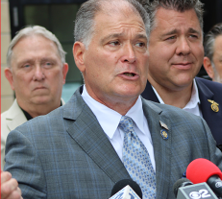
Previously Published in The Messenger
By Raheem Soto
It’s not every day that New York politicians agree on something. But when it comes to the state’s catastrophic overhaul of its home care system, even long-time observers are calling this mess next level.
The CDPAP disaster—New York’s so-called “reform” of the Consumer Directed Personal Assistance Program— has quickly become one of the recent most chaotic and confusing government shake-ups. As stories pour in about technical failures, missing paychecks, and families left in the dark, Republican lawmakers are demanding that Washington step in and clean up the mess.
For nearly 250,000 elderly and disabled New Yorkers, CDPAP is not just a line item in a budget—it’s a lifeline. The program lets patients hire their own caregivers, often family members, to help them with day-to-day needs. It’s flexible and trusted; for many, it’s the only way they can live safely and independently at home.
But in a rushed attempt to “streamline” the $9 billion program, Governor Hochul’s (D) administration scrapped a network of nearly 700 local fiscal intermediaries—the folks who handle payroll, paperwork, and support— and replaced them with a single out-of-state contractor: Public Partnerships, LLC.
What could possibly go wrong? Plenty, it turns out.
Since the transition began, caregivers and patients across the state have reported everything from long call wait times and glitchy software to outright misinformation. In some cases, caregivers say they haven’t been paid for weeks. Others are struggling to navigate enrollment, which is confusing at best and impossible at worst.
The original transition deadline was April 1, and tens of thousands of families still haven’t registered. The Governor extended the deadline by 30 days. But to families already in panic mode, that’s just kicking the can down the road.
According to the Senate Republicans, Senator Mario Mattera (R-St. James) among them, who released a blistering letter to the U.S. Department of Health and Human Services last week, the situation is beyond the state’s ability to fix. They’re calling on HHS Secretary Robert F. Kennedy, Jr. (I-CA) to launch a full investigation into the “slipshod” rollout and examine how this rushed change could impact vulnerable New Yorkers.
And make no mistake: this isn’t just a political talking point.
From the Southern Tier to South Brooklyn, families who depend on CDPAP are facing real consequences. Some have lost their caregivers. Others are terrified they might lose services altogether because they missed a technical step or never received the proper forms. The fear is real—and it’s spreading fast.
Republican senators didn’t hold back in their response. They described the situation as “a disaster from the start” and said the risks of the transition far outweigh any promised benefits. They also questioned why the state handed a no-bid monopoly to a single vendor— one with no local roots and little accountability.
Meanwhile, reports estimate that over 40,000 patients are being pushed into licensed home care agencies simply because of backlogs, glitches, or confusion. That means less freedom, less control, and often—less care.
This isn’t just a case of bureaucratic bumbling. For families caught in the middle, this is about survival. CDPAP allows New Yorkers with disabilities and chronic illnesses to stay in their homes, avoid institutionalization, and maintain some control over their daily lives. It keeps grandparents with their grandchildren, lets disabled adults hire siblings or spouses, and gives families peace of mind.
The rollout has been so poorly managed that lawmakers are now pushing legislation to delay the entire process by 90 days. That’s the bare minimum, they say. But more than just a delay, many call for the state to scrap the plan entirely and return to a regional model that prioritizes flexibility and local control.
Even Democrats in some districts reportedly feel the heat from angry constituents, though few have spoken up publicly. For now, the Senate GOP is leading the charge— and speaking out for the home care users who feel ignored and abandoned.
Critics of the transition say it’s just another example of top-down governance gone wrong. Instead of asking patients and providers what works, Albany underwent a massive overhaul with little transparency and oversight. Now, there is little hope of success.
To make matters worse, the Department of Health has reportedly been scrambling behind the scenes, even asking state employees to volunteer for support roles as the transition spirals out of control. Millions in taxpayer dollars have already been handed to PPL, but the out-of-state vendor is now under fire.
So where does it go from here?
If the Trump Administration’s Health Department answers the Senate’s call, we may finally get some answers—and hopefully, some accountability. But unless swift action is taken, families will continue to suffer the most.
The Governor’s team insists the transition will work in the long run. But for families trying to care for a disabled child or an aging parent today, “in the long run” doesn’t cut it, and they’re tired of Albany pretending that this chaotic rollout is anything but a disaster in real-time.
The bottom line is that CDPAP isn’t just a government program but a human safety net. When the state pulls that net away without a plan, people fall through the cracks. And in this case, the cracks are gaping.

